2003 Indiana Farmland Values & Cash Rents Continue to Increase
August 1, 2003
PAER-2003-7
Craig L. Dobbins and Kim Cook
The June 2003 Purdue Land Values Survey found that on a state-wide basis bare Indiana cropland ranged in value from $1,966 to $3,035. These values are based on 323 surveys received from professionals that are knowledgeable of Indiana’s farmland market. Poor land had an estimated value of $1,966 per acre, average land had an estimated value of $2,509 per acre, and top land had an estimated value of $3,035 per acre (Table 1). For the 12-month period ending in June 2003, this was an increase of 5.2%, 5.3% and 4.9%, respectively for poor, average, and top land.
Part the difference in land values reflects productivity differences. As a measure of productivity, survey respondents were asked to estimate long-term corn yields. The average reported yield was 103, 134, and 163 bushels per acre, respectively for poor, average, and top quality land. The value per bushel for different land qualities was very similar. Poor land was the most expensive at $19.07 per bushel. Top land had the lowest value at $18.59 per bushel and average land was $18.79 per bushel.
The average value of transition land* increased this year, reversing the decline that occurred in last year’s survey. The average value of transition land in June 2003 was $6,936 per acre, an increase of 7.6% from June 2002. Due to the wide variation in estimates for transitional land, the median value** may give a more meaningful picture than the arithmetic average. The median value of transitional land in June 2003 was$5,500 per acre.
Statewide Rents
Cash rents increased statewide from 2002 to 2003 by $2 to $4 per acre (Table 2). The estimated cash rent was $147 per acre on top land, $120 per acre on average land, and $93 per acre on poor land. This was an increase in rental rates of 2.2% for poor land, 3.4% for average land, and 2.8% for top land. Rent per bushel of estimated corn yield was $0.90 per bushel for all land classes. Cash rent as a percentage of value continued to decline. For top and average farmland, cash rent as a percentage of farmland value was 4.8%. For poor farmland, cash rent as a percentage of farmland was 4.7%. These values are the lowest achieved in 27-year history of the Purdue Land Value Survey.
__________
* Transitional land is land that is moving out of agriculture.
** The median value is the value in the middle of data that have been arranged in ascending or descending numerical order.
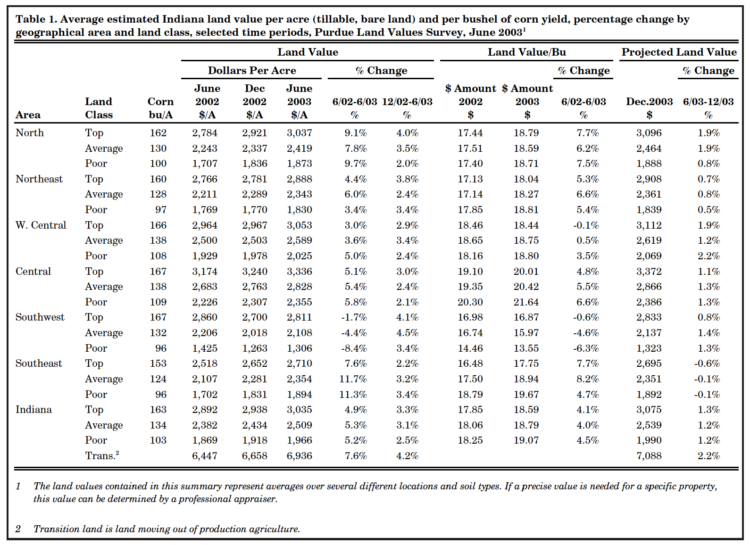
Table 1. Average estimated Indiana land value per acre (tillable, bare land) and per bushel of corn yield, percentage change by geographical area and land class, selected time periods, Purdue Land Values Survey, June 20031
Area Land Values
Changes in the value of farmland in the six different geographic areas of Indiana (Figure 1) for December 2002 to June 2003 ranged from a 2.1% increase for poor land in the Central region to a 4.5% increase for average land in the Southwest region (Table 1). All regions of the state reported strong increases in farmland values for this six-month period. The strongest region was the Southwest with increases ranging from 3.4% to 4.5%.
For the year ending June 2003, the change in land values ranged from a decline of 8.4% for poor land in the Southwest region to an increase of 11.7% for average land in the South-east region. In the Southwest region, the increase in value during the six-month period from December 2002 to June 2003 was not sufficient to off-set earlier reductions. All classes of land in this region declined for the year ending June 2003. The strongest increases for the year were in the Southeast region, ranging from 7.6%to 11.7%. This was followed by the North region with increases ranging from 7.8% to 9.7%.
The highest valued top-quality land was in the Central area, $3,336 per acre. This region was followed by West Central ($3,053), North ($3,037), Northeast ($2,888), South-west ($2,811), and Southeast ($2,710).
Land value per bushel of estimated average corn yield (land value divided by bushels) is the highest in the Central region, ranging from $20.01 to $21.64 per bushel. This was followed by the North, Northeast and West Central with values ranging from $18.04 to $18.81. The Southwest had the lowest land value per bushel, ranging from $13.55 to $16.87. This region also had the widest range of values.
Respondents were asked to estimate the value of rural home sites with no accessible gas line or city utilities and located on a black top or well-maintained gravel road. The median*** value for five-acre home sites ranged from $5,000 to $8,500 per acre (Table 3). Estimated per acre median values of the larger tracts (10 acres) ranged from $4,750 to $7,500 per acre.
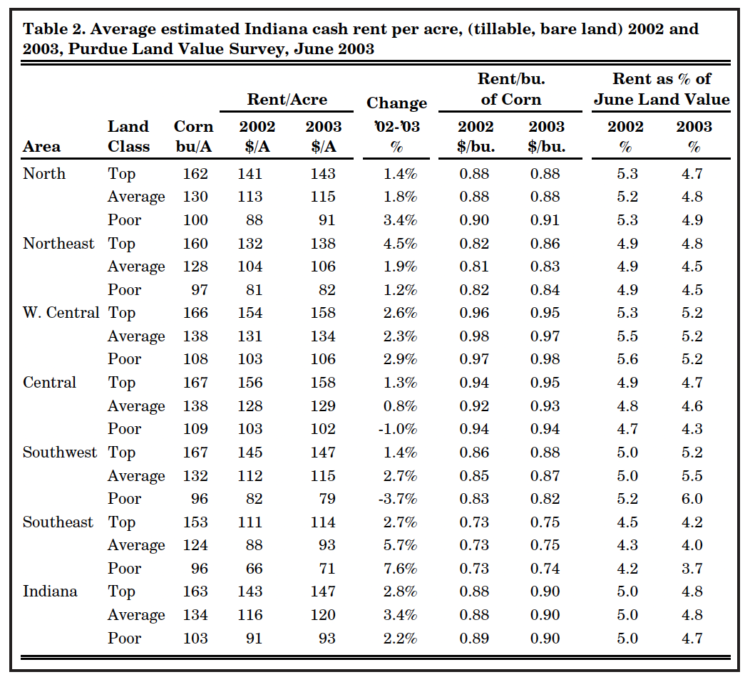
Table 2. Average estimated Indiana cash rent per acre, (tillable, bare land) 2002 and 2003, Purdue Land Value Survey, June 2003
__________
*** The median value is the value in the middle of data that have been arranged in ascending or descending numerical order.
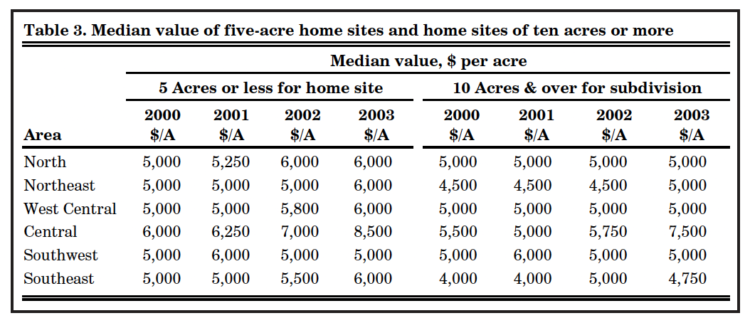
Table 3. Median value of five-acre home sites and home sites of ten acres or more
Area Cash Rents
All areas of the state reported increases in cash rent (Table 2). Only the Central and Southwest region reported a decline in cash rent. In both regions, the cash rent for poor land declined. The strongest increase in cash rent occurred in the South-east region.
Cash rents are the highest in the Central and West Central regions. The cash rent for top land in both regions was $158 per acre. Cash rents per bushel for the West Central and Central regions ranged from $0.93 to $0.98 per bushel. These per bushel rents are the highest in the state. The next highest per-bushel rent was in the North, ranging from $0.88 to $0.91 per bushel. Per bushel rents in the Northeast and Southwest ranged from $0.82 to $0.88. The lowest per bushel cash rents were $0.74 to $0.75, reported for the Southeast.
Important Factors in the Land Market
Several factors influence farmland prices. The supply of land on the market, the number of buyers interested in making a farmland purchase, and expectations about grain prices, interest rates, and the rate of inflation are just a few examples. To assess the supply of land on the market, respondents were asked to provide their opinion about the amount of farmland on the market now compared to a year earlier. The respondents were asked to indicate if there was more, less, or the same amount of land on the market now compared to a year earlier. Eight-six percent of the respondents indicated that the amount of land on the market at the current time was the same or less. These results are nearly the same as past years (Figure 2). Only 15% of the respondents indicated there was more farmland on the market. These results indicate the supply of land for sale remains limited.
To assess the amount of market activity, respondents were asked to provide their opinion of the number of farmland transfers in the past six months compared to a year earlier. The respondents could indicate that the number of transfers was up, down, or the same as a year earlier. Again, the largest number of respondents indicated the number of farmland transfers was the same as a year ago (Figure 3). However in this case, there has been a steady rise in the number of respondents indicating an increase in the number of transfers and a steady decline in the number of respondents indicating a decline. These changes indicate that there has been some increase in the number of farmland transfers.
Respondents were asked to provide their perceptions of changes in the buyers of farmland by indicating if purchases by farmers, rural residents, nonfarm investors, or pension funds had increased, decreased, for remained the same when compared to a year earlier. Demand from farmers and nonfarm investors have shown the largest changes. This year, just over 43% of the respondents indicated that there was an increased demand from farmers (Figure 4). This continues an upward trend in the number of respondents indicating increased farmer interest in farmland purchases.
The demand for rural residents continues to be strong, 76% of the respondents indicated an increase in demand for rural residences. Twenty-four percent indicated that demand for rural residences remained the same. One percent of the respondents indicated a decline in the demand for rural residents. These responses are similar to those of past years.
With the decline in the rates of return for competing investments such as the stock market, one might expect there to be increased demand for farmland by nonfarm investors. The number of survey respondents reporting increased interest on the part of nonfarm investors was just over 58% (Figure 5). This is a sharp increase over last year’s value. The number of respondents indicating the same or less interest on the part of nonfarm investors declined.
Respondents also indicated an increase in interest by pension funds and other types of combined farmland investors. While 63% of the respondents indicated that interest from these investors was the same as last year, this year 21% of the respondents indicated increased interest from these investors and 17%indicated decreased interest. Last year 14% of the respondents indicated increased interest and 24% of the respondents indicated decreased interest. While these investors are not expected to become big buyers of farmland, these data indicate more interest in farmland investments.
Expected Corn and Soybean Prices, Interest Rate, and Inflation Expectations regarding crop prices over the next few years have a strong influence on farmland values because they affect expected revenues from the purchase or rental of farmland. In order to gain insight into price expectations, respondents were asked to estimate the annual average on-farm price of corn and soybeans for the period 2003 to 2007. Respondents have been asked to make these five-year projections since 1984.
This year saw an increase in the expected five-year average price of corn and soybeans (Table 4). This ended the six-year decline in expectations for corn and the five-year decline in expectations for soybeans. These price expectations indicate a more positive revenue outlook.
Other important expectations associated with a land purchase include the expected farm mortgage interest rate and the rate of inflation. The estimated five-year average interest rate declined again this year; indicating that survey respondents expect interest rates to remain low. This is the lowest expected interest rate in the series. The expected five-year average rate of inflation also continues to drift lower.
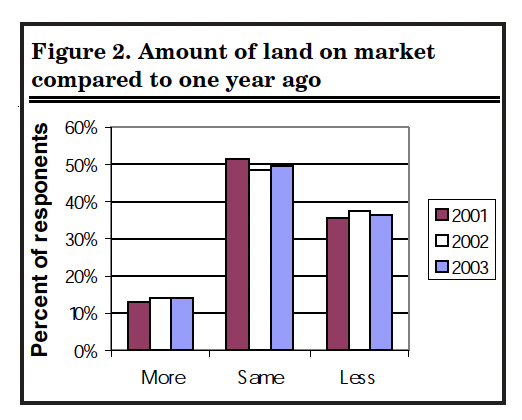
Figure 2. Amount of land on market compared to one year ago
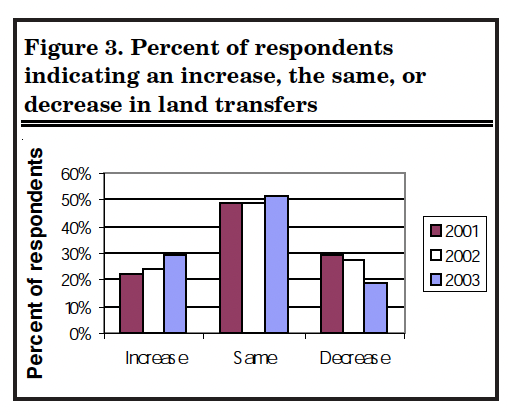
Figure 3. Percent of respondents indicating an increase, the same, or decrease in land transfers
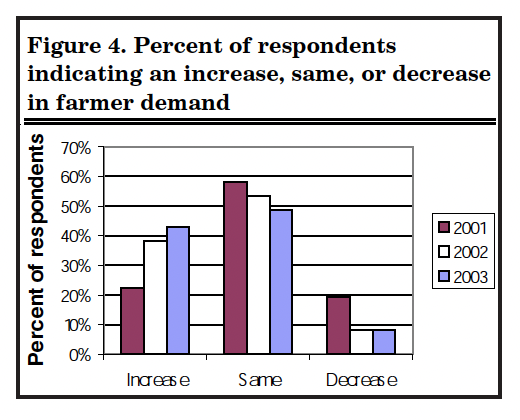
Figure 4. Percent of respondents indicating an increase, same, or decrease in farmer demand

Figure 5. Respondents indicating an increase, same, or decrease in demand from nonfarm investors
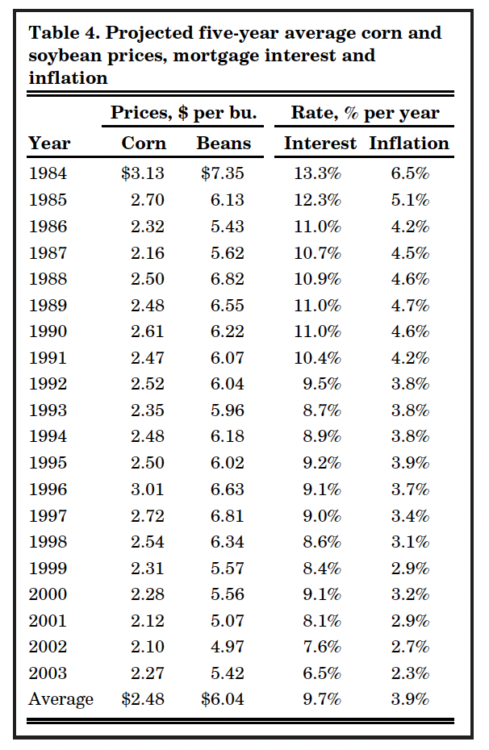
Table 4. Projected five-year average corn and soybean prices, mortgage interest and inflation
Factors Influencing Current Farmland Values
To obtain a more comprehensive assessment of the relative strength that various influences are currently exerting on farmland values, survey respondents were asked to assess the influence of 11 different items on farmland values. These items included:
- Current net farm income,
- Expected growth in returns,
- Crop prices & outlook,
- Livestock prices & outlook,
- Current & expected interest rates,
- Returns on competing investments,
- S. agricultural export sales,
- S. inflation/deflation rate,
- Current inventory of land for sale,
- Current cash liquidity of buyers, and
- Current U.S. agricultural policy.
Respondents were asked to use a scale from -5 to +5 to indicate the effect each item has on current farmland values. If the item had a major negative influence, it would be given a minus 5. If the item had a small negative influence, it would be given a minus 1. Positive influences were assessed in the same way, except positive weights were used. A weighted average for each item was calculated, and the results are presented in Figure 6. The numbers on the horizontal axis of the chart indicate the number of the influence in the above list.
Those items with the largest negative influences included current net farm income (1) and current livestock price level and outlook (4). The crop price level and outlook (3) and export sales (7) also have negative influences, but these are less important than in previous years. Those with the largest positive influences include current and expected interest rates (5), returns on competing investments (6), the current inventory of land for sale (9), the current cash liquidity of buyers (10), and the inflation/deflation rate (8).

Figure 6. Factors Influencing Current Farmland Values
What about the Future?
The limited supply of land for sale combined with strong demand for country residences and nonfarm development, the strong liquidity of buyers, renewed interest by farmers and nonfarm investors in farmland purchases, and low long-term interest rates continues to provide strength to Indiana’s farmland market. When the long-awaited economic recovery of the U.S. economy begins, interest rates and the attractiveness of alternative investments are likely to improve. However, even with some increase in interest rates, the other factors supporting Indiana’s farmland market are likely to remain in place. When asked to project farmland values for December 2003, respondents expected farmland values in all areas except the Southeast to increase (Table 1). In the Southeast, respondents expected a small decline in farmland values.
On a state-wide basis, survey respondents expect farmland values to increase 1.2%
to 1.3% between June 2003 and December 2003.
Respondents were also asked to project farmland values five years from now. Seventy-nine percent of the respondents expected farmland values to be higher, 14% of the respondents expected farmland values to be the same, and 7%expected farmland values to be lower. Overall, respondents expect land values to be 7.1% higher in five years.
Some people have wondered if the real estate market might be the next market bubble to burst. What could derail a continued increase in farmland values? One possibility is a sharp rise in inflation and interest rates because of the large federal budget deficit. A sharp rise in
long-term interest rates would slow development demand, provide more attractive alternative investments, as well as increase the cost of borrowed money. Another possibility could be a sharp drop in commodity prices do to a surge in world production. While this would reduce market revenues, the current farm program would offset lower market prices with increased counter cyclical payments. Still another possibility is a sharp rise in production costs. The tight supply of natural gas resulted in higher nitrogen prices this past spring. Natural gas supplies continue to be tight and may increase propane prices this fall. If these and other input costs rise, margins from crop production are likely to narrow, reducing the income capitalized into farmland values.
While the likelihood of these events or their impact may seem low, it is important to remember that a farmland investment is a long-term investment. Prudent planning requires investigating if there is a sufficient cushion to allow the business to withstand unexpected events that reduce net revenue. It is also important to remember that farmland is an illiquid investment. Selling a tract that should not have been purchased can often take longer than anticipated. If a farmland sale is planned, the data reported here provides general guidelines regarding farmland values. To obtain a more precise value for an individual tract, contact a professional rural appraiser.
**********
The land values survey was made possible by through the cooperation of numerous professionals that are knowledgeable about Indiana’s farmland market. These professionals include farm managers, appraisers, land brokers, bankers, Purdue Extension educators, farmers, and persons representing the Farm Credit System, the Farm Service Agency
(FSA) county offices, and insurance companies. Their daily work requires that they stay well informed about land values and cash rents in Indiana. The authors express sincere thanks to these friends of Purdue and of Indiana agriculture. They provided 323 responses representing all but one Indiana County. We also express appreciation to Carolyn Hunst of the Department of Agricultural Economics for her help in conducting the survey.

Figure 1. Geographic Areas Used in the Purdue Land Values Survey

